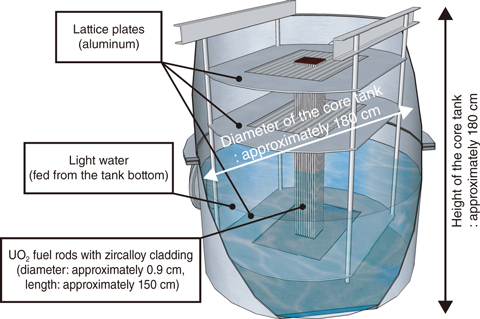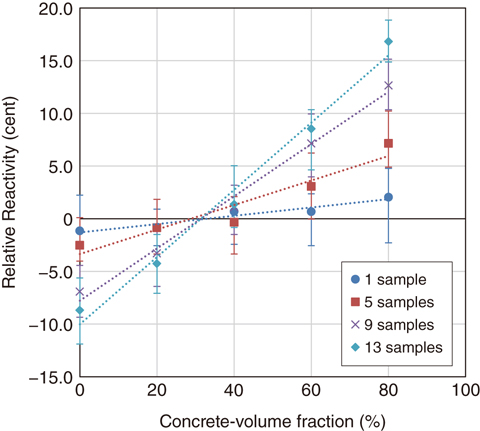
Fig.2-15 Overview of the modified STACY

Fig.2-16 Estimation of reactivity changes using a number of samples and the concrete volume fractions of pseudo fuel debris
In the accident at the TEPCO’s Fukushima Daiichi NPS, it is conceivable that fuel debris may have formed from melted nuclear fuels and structural materials such as iron and concrete. It is important to evaluate the criticality characteristics of fuel debris using computational models for the decommissioning project including defueling. Furthermore, we should validate the uncertainties of the computations using critical experiments with pseudo fuel debris to clarify their criticality characteristics. For this purpose, the modification of STACY, whose core is being converted from a uranyl-nitrate-solution-fuel type to a UO2-fuel-rod-and-water-moderator type, is now underway at JAEA.
As shown in Fig.2-15, the fuel rods will be arrayed at some interval and supported by lattice plates in the modified STACY core tank. The moderator-to-fuel-volume ratios (Vm/Vf) of the test core will be varied by changing the array interval. The criticality characteristics of fuel debris are largely influenced by Vm/Vf as well as the total amount of fissile material and the geometries of fuel debris. Furthermore, the pseudo fuel debris including concrete will have specific critical characteristics because concrete includes water, contributing to neutron moderation. In the critical experiment, we will measure variation of the critical water heights; one of them is a base-core configuration comprising only a normal fuel-rod array; the other is a core configuration with pseudo fuel debris. The variation will be interpreted into a critical characteristic called “reactivity” (unit: cent).
We studied the experimental core configurations and the necessary numbers of samples for high-accuracy reactivity measurements of pseudo fuel debris using the radiation-transport-calculation-code system MCNP 5.1 and the evaluated nuclear-data library JENDL4 evaluated by JAEA. For example, when Vm/Vf is 1.2, the calculation results of reactivity effects by the changing concrete-volume fraction are shown in Fig.2-16. This figure shows that the concrete-volume fraction has a big impact upon the reactivity, and there is a tendency for reactivity to become more positive with increase in the concrete-volume fraction. It is thought that the number of samples should be at least five to realize a condition with reactivity sufficiently large to be measured easily. In contrast, when the concrete-volume fraction is 30%, the reactivity change is too small to be measured. In this case, we should consider changing the experimental-core configuration. Following these studies, we are going to establish experimental conditions and procedures using the modified STACY. Furthermore, the measurement data from critical experiments will be useful for developing the methods for critical control of fuel debris.
This study includes the results of contract work funded by the Secretariat of the Nuclear Regulation Authority (NRA) of Japan.